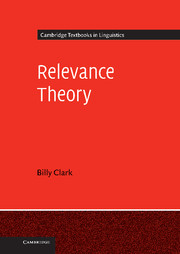Appendix - Key notions of relevance theory
Published online by Cambridge University Press: 05 June 2013
Summary
This Appendix contains a brief summary of some of the key technical notions involved in understanding the central claims of relevance theory. The aim is to provide one place in the book where you can remind yourself of some of the key theoretical notions. I have focused on those which are particularly useful in relevance-theoretic accounts of how particular acts of communication or other phenomena are understood. The appendix can be used as a stand-alone presentation of key ideas as well as something to refer to while reading through the rest of the book.
Of course, all of these notions are discussed in more detail in the rest of the book and have also been much discussed in the literature. It is always hard to know whether to present complex ideas from the ‘bottom up’ (so that no statement presupposes anything which has not yet been introduced) or from the ‘top down’ (starting with the broad claims and then explaining the terms mentioned within them). The advantage of the bottom-up approach is that no part of the story at a level higher than the base level requires readers to trust that there will be an account at some stage of how the lower levels work. The advantage of the top-down approach is that the bigger picture is clearer sooner. Both directions involve trust since students or readers are asked either to trust that new terms which have not yet been explained will be defined later or to trust that there will be a valid reason for having introduced this particular series of technical terms. Here I have gone mainly with the ‘bottom-up’ approach starting with cognitive effects and working up to the two Principles of Relevance (although the discussion does depart from the ‘bottom to top’ ordering a little on the way). The order in the book is more ‘top-down’ than ‘bottom-up’. For now, though, let's take it from the bottom.
- Type
- Chapter
- Information
- Relevance Theory , pp. 363 - 366Publisher: Cambridge University PressPrint publication year: 2013



